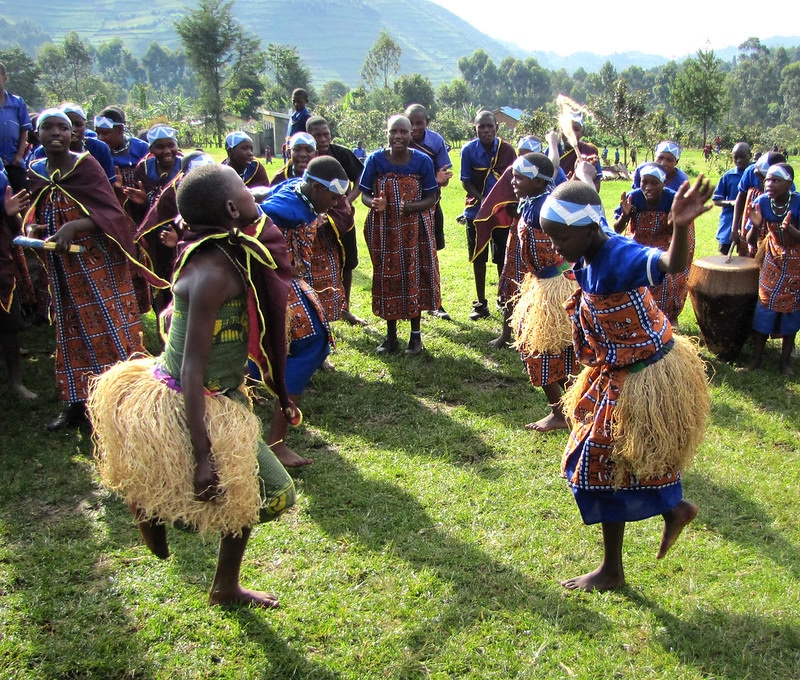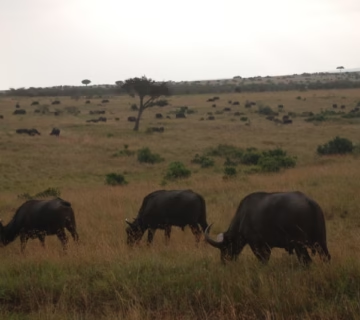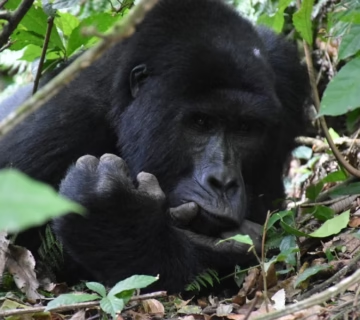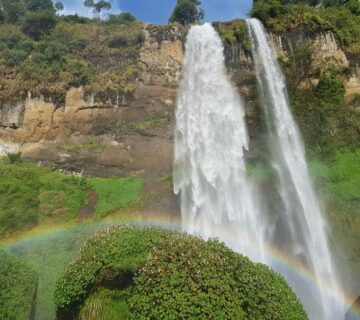Rubuguri Village Walk In Bwindi Forest Park
The Rubuguri Village Walk is in Bwindi Forest Park. Rubuguri is in the southern part of the park, in the lower lands of Bwindi Impenetrable. It is between the Rushaga and Nkuringo areas of the national park. A lot of people live in Rubuguri Village, which is surrounded by hills that rise and fall. The town can only be reached by car. The city of Rubuguri is in the Kisoro District of Kirundo Sub County. Cities like Kihihi, Kabale, Kanungu, Kambuga, Cyahafi, and Rubale are all around it.
THE VILLAGE WALK IN RUBUGURI FOREST PARK
Bwindi Impenetrable National Park is in the southwest of Uganda, in the Kanungu District. It is close to the border with the Democratic Republic of the Congo and the Rift Albertine. It is a UNESCO World Heritage Site. There are both lowland and afro-montane woods in Bwindi’s 321 square kilometers. The main thing that draws people to this park are the over 400 mountain gorillas that live there naturally. Bwindi is also home to over 300 tree species, over 360 bird species, over 300 butterfly species, and 120 animal species.
A walk through Rubuguri Village in the Bwindi Forest Park is something else that can be done in Bwindi besides going monkey climbing. On the Rubuguri village walk, you will go through green swamps, rolling hills, and steep rock walls on your way to the traditional houses of the locals. It is there that you will meet them. The Rubuguri Village Walk is run by the Nkuringo Cultural Center (NCC). As part of the Rubuguri village walk, visitors will see homesteads where people do daily tasks like farming, feeding and caring for animals, visiting gardens and farms, and doing chores like cooking and preparing food. Tourists may even eat with the people sometimes.
People who live in the villages along the Rubuguri village walk are friendly and willing to make tourists feel welcome. This will then make it easier for people to connect with each other, letting tourists learn more about the current and past ways of life of the locals. Tourists will learn more about how people in the area act and behave by spending time with them.
People who go on the Rubuguri village walk can enjoy the traditional songs and dances that the people there perform to welcome them. Legends, stories, and puzzles will be told to you that show how the people in the area lived in the past. This happens when tourists and locals talk to each other directly.
The Batwa were the first people who lived in the forest and later moved out of the park. On the village tour, tourists will meet the Batwa people, who will tell them stories about how they live in the forest. There will be shows of traditional dances and songs, as well as other things to do, like showing off your skills at crafting, honey collecting, hunting, and gathering fruits and vegetables. You can also meet a blacksmith and herbalists who use local herbs. This way, guests will learn a lot because they can take part while they are being taught. exploring and learning about the practices, values, and ways of life of the Batwa people.
An important part of the trip is going to the local schools while walking through the town of Rubuguri. This means going to places like St. Peter’s Primary School, where guests enjoy talking to the students and teachers, who make them feel welcome and give them something fun to do. Traditional Kikiga songs and dances, like the Bakiga (a dance where people jump high and stomp the ground), are used to show this.
People who go on the Rubuguri Village Walk in Bwindi Forest Park can see some of the locals’ arts and crafts projects. These include making baskets, bags, huts, and mats, among other things. For guests, the chance to help make them will be given because they will be shown how to do it. The products will also bring in money for the people because guests will buy them. If you take a walk through the town of Rubuguri, you’ll see beautiful views of traditional African houses, swamps, and hills with terraces.
WHAT IS THE BEST TIME TO DO THE VILLAGE WALK IN RUBUGURI?
People have always known that walks through Rubuguri town can be done at any time of the day or year. Because it is a jungle, the best months to visit are December, January, February, June, July, August, and September. These are called “dry months” or seasons because the park doesn’t get much or any rain during these times. And right now, there isn’t much greenery, and the roads and paths are clear, easy to use, and safe, which makes journey simple. However, March, May, October, and November are good times to go for a walk through the town of Rubuguri because it rains a lot those months. At this time of year, the roads and paths in the park are not in good shape—they are wet, slippery, muddy, and dangerous. This makes it hard to go hiking.
THE BEST PARTS OF THE RUBUGURI VILLAGE WALK
Visiting the native homes of the people who live there
How tourists and people interact with each other
Exploring and learning about the people who live there and their customs
Going to neighborhood schools and different projects
Seeing the different sights while on the walk.
HOW TO PLAN A TOUR TO RUBUGURI VILLAGE
Both your body and mind should be healthy. It’s true because you have to walk a long way.
To stay warm, put on hand gloves, a long-sleeved shirt or jacket, long pants, and good climbing boots that aren’t too heavy to carry while you walk.
Take a look at how long you stay. To do this, you need to find the best season.
You should bring a waterproof bag with you that has everything you need, like enough food, snacks, water, sunscreen, bug spray, hats, sunglasses, and a camera.
You might want to hire a helper to help you carry your bags if you have a lot of it.
To get help with the tour’s details, book with or deal with the best tour companies, like Maseke Adventure Co.Ltd.
OTHER THINGS THAT PEOPLE DO IN BWINDI IMPENETRABLE NATIONAL PARK
Going on an ape walk is the main thing that people do in the park. There are more than 20 habituated gorilla families that can be seen every day in the park’s different sectors. The Buhoma region has five gorilla families, the Ruhija sector has four gorilla groups, the Rushaga sector has eight gorilla families, and the Nkuringo sector has three gorilla groups.
In Bwindi Forest Park, you can take a walk through the village of Rubuguri.
The following gorilla families can be seen while hiking in the different areas: The Rushegura Group
Muse Group and Mubare Group
The Habinyanja Group
The Katwe Gorilla
The Nkuringo group is home to the Bushaho family, the Christmas group, the Bitukura group, the Oruzogo group, the Kyaguliro group, the Mukiza group, the Nshongi family, the Bikingi group, the Mishaya group, the Kahungye group, the Busingye family, the Bweza group, the Mucunguzi group, and the Rwigi group.
To walk these families, you need a gorilla trekking pass, which costs 700 dollars for foreigners who don’t live in East Africa, 600 dollars for foreigners who do live in East Africa, and two hundred and fifty thousand shs for East African citizens. It takes eight people to walk with each family every day, and guests can spend an hour with the gorillas.
Going on foot to find trained gorillas is part of the habituation process. This is done in the southern part of the park, which is made up of the Nkuringo sector with the Posho gorilla group and the Rushaga sector with the Kutu gorilla family. Each day, only eight habituation passes are given out, and each group of four people is only allowed to meet one gorilla family. There is a 4-hour ticket that lets tourists see the gorillas. It costs USD 1500 for foreigners who are not residents of East Africa, USD 1000 for foreigners who are residents of East Africa, and Ugx 750,000 for East African citizens.
Watching birds. In Bwindi, you can find many kinds of birds in and around waterfalls, swamps, and bamboo areas. These include the African sooty flycatcher, the African paradise flycatcher, the African goshawk, the African pygmy kingfisher, the black bee eater, the dwarf honeyguide, the African green broadbill, the black-billed turaco, Cassin’s grey flycatchers, African black ducks, the great blue turaco, and the handsome francolin. You can get to this from the falls trail, the River Ivy trail, the birdwatching trails, or the Kashasha river trail.
Track down animals. One of the best things about Bwindi is that you can track 11 different kinds of primates. These include chimps, baboons, galagos, blue monkeys, red-tailed monkeys, and white and black colobus monkeys.
Wildlife viewing, game viewing, or drives: These can be day or night trips that involve finding the park’s hidden gems, such as its different plant communities and animals, such as gorillas, side-striped jackals, clawless otters, civets, wild pigs, warthogs, giant forest hogs, forest elephants, bush bucks, duikers, and buffaloes. And the different kinds of birds, trees, animals, and snakes. Other things to do are:
Taking a boat ride
Mountain bike riding
Forest walks in the woods
Camping trips and tours of museums.
BWINDI IMPENETRABLE NATIONAL PARK HAS PLACES TO STAY WHILE ON THE RUBUGURI VILLAGE WALK
There are a huge number of places to stay, ranging from high-end to moderately priced. Along with the Nshongi gorilla camp, the budget range has the Ruhija community rest camp, the Ruhija gorilla friends resort, the Mutanda Eco community center, the Crested Crane Bwindi, the Engagi lodge, the CPTH gorilla conservation camp, the Bwindi view Bandas, the Bwindi guest house, the Bwindi back packers lodge, the Bwindi forest lodge, the Buhoma community Banda, and the Broadbill forest camp.
There are a lot of places to stay in the middle price range, such as Gorilla Valley Lodge, Lake Muhele Gorilla Lodge, Bwindi Jungle Lodge, Buhoma Community Haven Lodge, Cuckoo Land Tented Lodge, Eco Marvels Gorilla Resort, Gift of Nature, and Gorillas Mist Camp.
Buhoma Lodge, Bwindi Clouds Lodge, Chameleon Hills Lodge, Mahogany Springs, Ichumbi Lodge, Nkuringo Bwindi Gorilla Lodge, Rushaga Gorilla Resort, Rushaga Gorilla Safari Lodge, Sanctuary Gorilla Forest Camp, Silverback Lodge, and Trekkers Tavern Cottages are some of the high-end places to stay.



